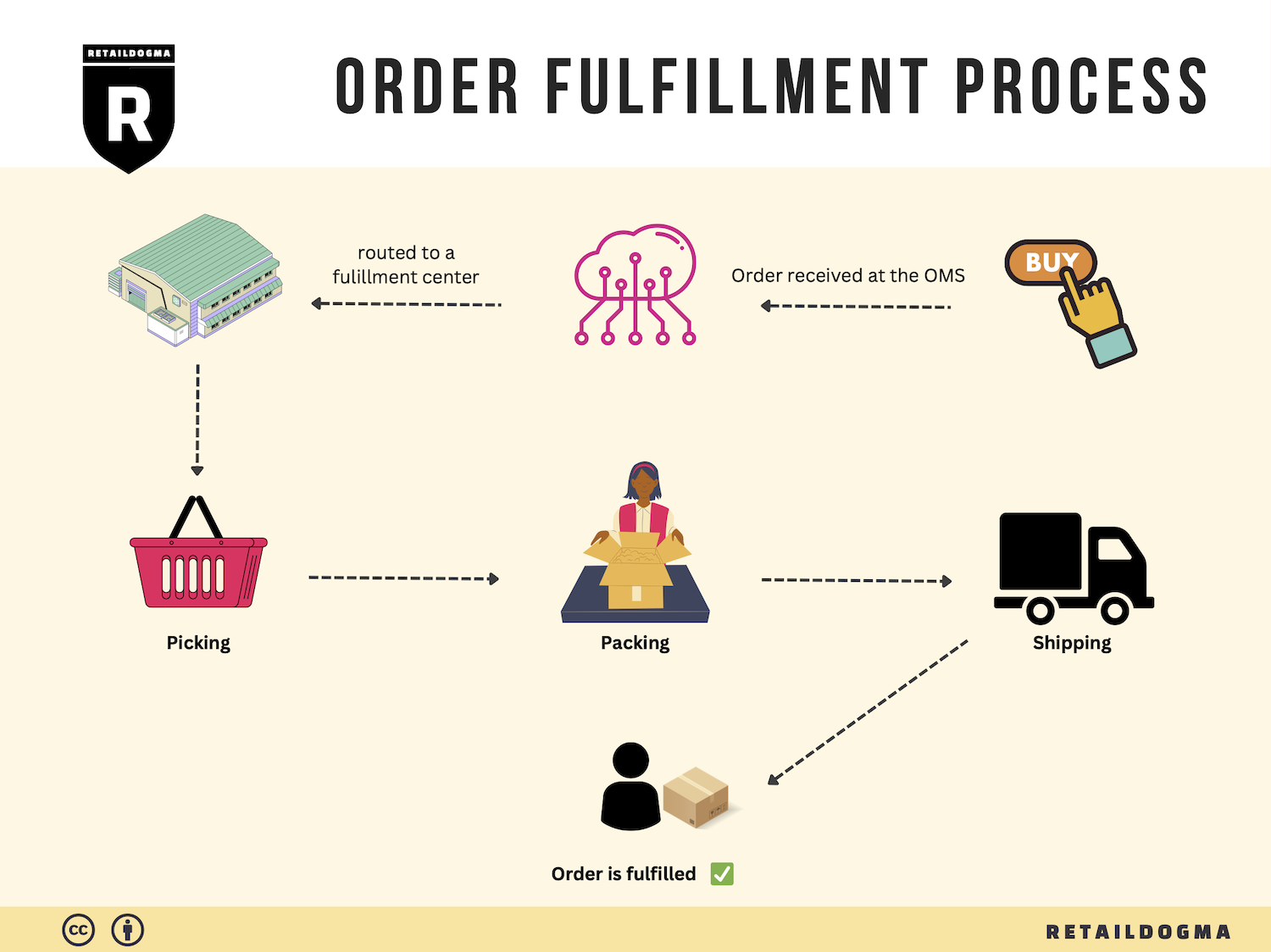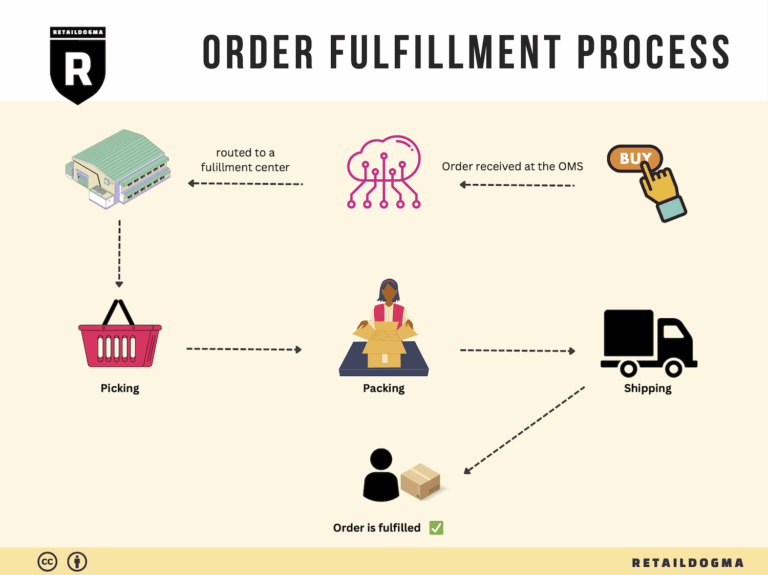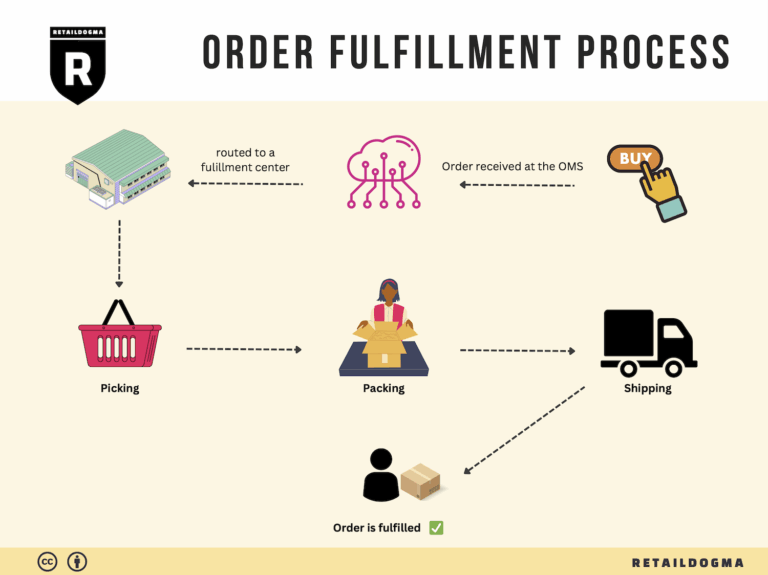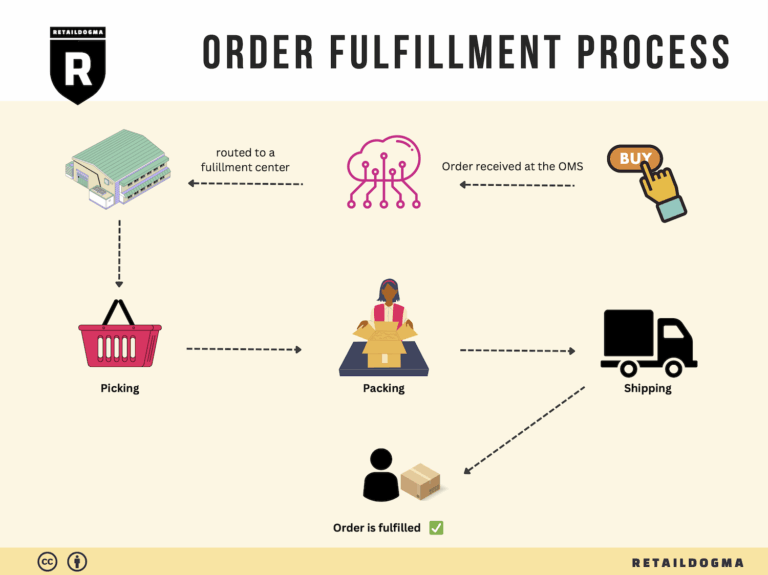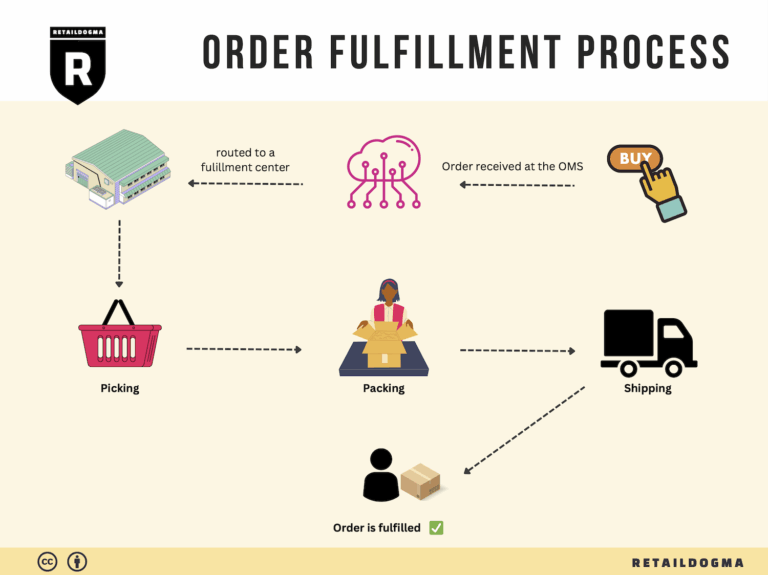Ecommerce Fulfillment Services: The Ultimate Guide (2025)
What is E-commerce Fulfillment? An Introduction for Growing Businesses
Understanding the Challenges of E-commerce Fulfillment
As a growing online business owner, you may find yourself grappling with the complexities of packing and shipping orders. The excitement of acquiring new customers can quickly turn into stress when you realize that fulfilling their orders is consuming more time and resources than you anticipated. This is a common pain point for many entrepreneurs: the logistical demands of e-commerce can easily overwhelm your operations, detracting from your ability to focus on product development and marketing.
Fulfillment, at its core, is the process of getting a product to a customer. It encompasses everything from inventory management and order processing to packing and shipping. Effective fulfillment is crucial for maintaining customer satisfaction and driving repeat business, yet many growing businesses struggle to manage these logistics efficiently. This guide aims to demystify e-commerce fulfillment by providing you with essential insights and practical strategies.
What This Guide Covers
In this comprehensive guide, we will explore the various fulfillment models available to e-commerce businesses, including Third-Party Logistics (3PL) and Fulfillment by Amazon (FBA). Each model has its unique benefits and challenges, and understanding these will help you make informed decisions about which approach best suits your business needs.
We will delve into the core services that fulfillment partners offer, such as inventory storage, order processing, packing, and shipping. Additionally, we’ll discuss how to choose the right fulfillment partner, highlighting key considerations such as scalability, cost, and expertise.
Pricing is another critical aspect of fulfillment that we will address. Understanding the costs associated with different fulfillment models will empower you to budget effectively and maximize your profit margins.
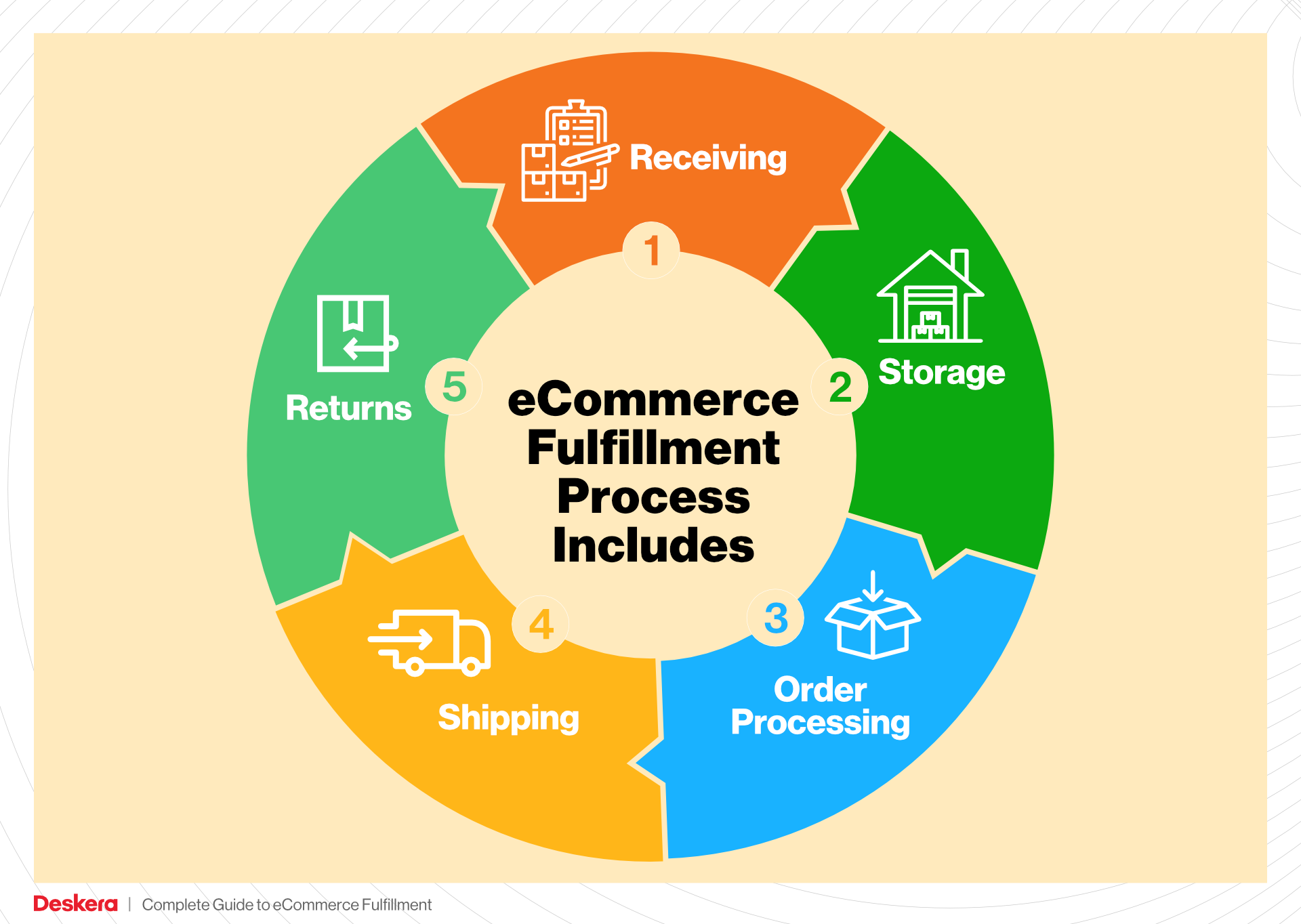
Empowering Your Business Decisions
The ultimate goal of this guide is to empower you to make smart decisions about your logistics strategy. By providing a clear understanding of e-commerce fulfillment processes and options, you will be better equipped to streamline your operations, enhance customer satisfaction, and scale your business successfully. Whether you’re just starting out or looking to optimize your existing fulfillment processes, the insights shared here will serve as a valuable resource in your journey to achieving e-commerce success.
What You’ll Learn In This Guide
- What is E-commerce Fulfillment? An Introduction for Growing Businesses
- The Order Fulfillment Process: From ‘Buy’ Button to Customer’s Door
- Comparing Fulfillment Models: In-House vs. 3PL vs. Dropshipping
- A Deep Dive into Amazon FBA: Pros, Cons, and Who It’s For
- Core Services Offered by Fulfillment Centers
- How to Choose a Fulfillment Partner: A 6-Point Checklist
- Understanding Fulfillment Pricing: A Breakdown of Common Fees
- Frequently Asked Questions (FAQs) about Fulfillment
- Conclusion: Is Outsourcing Fulfillment the Right Move for Your Business?
- Important Disclaimer
The Order Fulfillment Process: From ‘Buy’ Button to Customer’s Door
1. Receiving Inventory
The order fulfillment process begins with receiving inventory, which is a critical step in ensuring that your e-commerce business has the products necessary to meet customer demand. When your products arrive at the fulfillment center, they undergo a systematic check to verify that the correct items and quantities have been delivered. This process often involves using Stock Keeping Units (SKUs), which are unique identifiers for each product, to streamline the verification process.
Why is this step important? Proper inventory reception minimizes discrepancies and errors that can lead to stockouts or overstock situations. Ensuring that your inventory is accounted for accurately lays the foundation for a smooth fulfillment process. Additionally, leveraging technology such as barcode scanners can significantly enhance accuracy and efficiency during this phase.
2. Warehouse Storage
Once inventory is received and verified, the next step is warehouse storage. This involves organizing the products in a manner that optimizes space and accessibility, often using warehouse management systems (WMS) to track product locations. Products can be stored in designated zones based on various criteria, such as sales velocity or product type.
Effective warehouse storage is crucial for several reasons. First, it helps in reducing the time taken to pick products later in the fulfillment process. A well-organized warehouse ensures that items are easy to locate, thereby speeding up order processing times. Moreover, proper storage can also prevent damage to products, particularly for sensitive items that require climate-controlled environments.
3. Order Picking
Order picking is the step where items are selected from their storage locations to fulfill customer orders. This process typically involves generating pick lists, which are documents or digital records that outline the items needed for each order, including their locations within the warehouse.
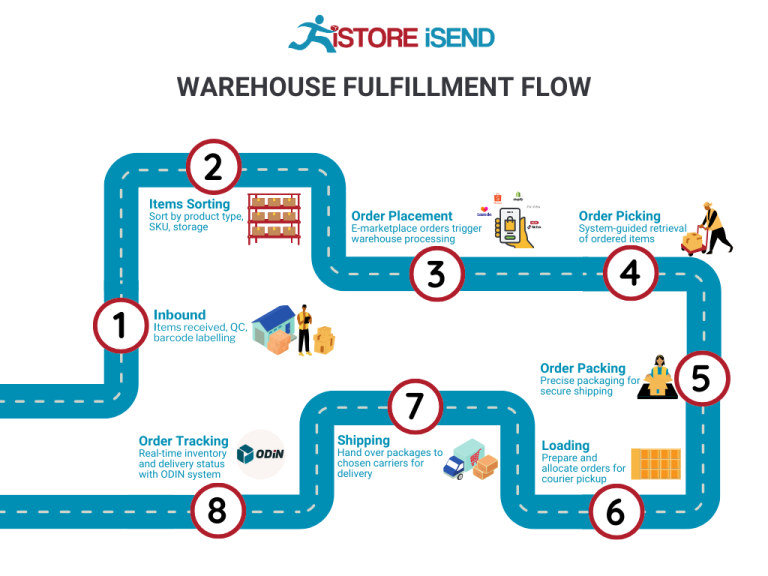
The importance of efficient order picking cannot be overstated. Quick and accurate picking directly impacts order lead times and customer satisfaction. Businesses can choose from various picking methods, such as single order picking, batch picking, or wave picking, depending on their order volume and warehouse layout. By optimizing the picking process, businesses can enhance productivity and reduce labor costs, ultimately leading to improved profitability.
4. Order Packing
Once the items are picked, they move to the packing stage. Here, the picked items are carefully packed to ensure they arrive at the customer’s door in perfect condition. This step often involves using packaging materials that protect the products during transit, as well as branded packaging that enhances the customer experience.
Packing is a vital step for several reasons. First, proper packaging minimizes the risk of damage during shipping, which can lead to costly returns and unhappy customers. Second, a well-branded package can create a positive unboxing experience, fostering customer loyalty. Efficient packing processes can also reduce shipping costs by optimizing package sizes and weights, ensuring that you are not overspending on shipping fees.
5. Shipping & Delivery
The final step in the order fulfillment process is shipping and delivery. Once the order is packed, it is labeled and handed over to a shipping carrier for delivery to the customer. At this stage, it is essential to utilize tracking systems that allow both the business and the customer to monitor the shipment’s progress in real-time.
This step is crucial because it represents the final interaction between your business and the customer. Timely and reliable shipping can significantly enhance customer satisfaction and encourage repeat purchases. Additionally, leveraging multiple shipping options can provide customers with flexibility, allowing them to choose the speed and cost that best fits their needs. By optimizing shipping routes and partnering with reliable carriers, businesses can further improve delivery times and reduce costs.
In conclusion, understanding and optimizing each step of the order fulfillment process is essential for e-commerce businesses looking to scale. By focusing on receiving inventory, warehouse storage, order picking, order packing, and shipping & delivery, businesses can enhance operational efficiency, improve customer satisfaction, and ultimately drive growth.
Comparing Fulfillment Models: In-House vs. 3PL vs. Dropshipping
Fulfillment Model Comparison
| Model | Who Handles Inventory | Best For (Business Stage) | Key Advantage | Key Disadvantage |
|---|---|---|---|---|
| In-House Fulfillment | Business itself | Established businesses | Complete control over inventory and processes | High overhead costs and complexity |
| Third-Party Logistics (3PL) | 3PL provider | Startups to mid-sized businesses | Cost savings and scalability | Less control over fulfillment processes |
| Dropshipping | Supplier | New businesses or niche markets | Low upfront investment | Longer shipping times and lower margins |
In-House Fulfillment
In-house fulfillment is when a business manages all aspects of its logistics operations internally. This includes storage, order processing, packing, and shipping. This model is typically favored by established businesses with sufficient resources and demand to justify the investment in warehousing and personnel. One of the primary advantages of in-house fulfillment is the complete control it offers over inventory and fulfillment processes. Companies can customize their operations to align perfectly with their brand values and customer expectations, ensuring a consistent experience. However, the major downside is the significant overhead costs involved, including rent, utilities, labor, and equipment. Additionally, managing logistics can divert attention from core business activities such as marketing and product development, making it a less appealing option for startups and smaller businesses looking to scale quickly.
Third-Party Logistics (3PL)
Third-party logistics (3PL) involves outsourcing fulfillment tasks to a specialized provider that manages storage, order processing, and shipping on behalf of the business. This model is ideal for startups and mid-sized companies that need to scale quickly without the burden of managing logistics themselves. One of the key advantages of using a 3PL provider is the cost savings associated with reduced overhead and the ability to leverage the provider’s expertise in inventory management and logistics. Additionally, 3PL services often come with advanced technology for tracking inventory and managing orders, which can enhance efficiency and accuracy. However, the primary disadvantage is the loss of direct control over fulfillment processes. Businesses must trust the 3PL provider to maintain their standards of quality and service, which can lead to challenges if the partnership does not align well with the company’s operational goals.
Dropshipping
Dropshipping is a fulfillment model where the retailer does not keep products in stock but instead transfers customer orders directly to a supplier, who then ships the products to the customer. This model is particularly attractive for new businesses or those targeting niche markets, as it requires minimal upfront investment and eliminates the need for inventory management. Retailers can offer a wide range of products without the risks associated with unsold stock, making it a low-risk entry point into e-commerce. However, dropshipping comes with its own set of challenges, including longer shipping times and potentially lower profit margins due to reliance on suppliers. Additionally, the retailer has less control over product quality and fulfillment speed, which can impact customer satisfaction. As businesses grow, they may find that the dropshipping model lacks the scalability and reliability needed to support a larger operation.
Conclusion
Choosing the right fulfillment model is crucial for the success of an e-commerce business. Each model—In-House Fulfillment, Third-Party Logistics (3PL), and Dropshipping—has its distinct advantages and disadvantages. In-house fulfillment offers control but at a high cost, while 3PL provides a scalable solution with cost savings but less control. Dropshipping presents a low-risk entry into e-commerce but may lead to challenges in customer satisfaction due to external fulfillment processes. Ultimately, the decision should align with the business’s stage, resources, and long-term growth strategy.
A Deep Dive into Amazon FBA: Pros, Cons, and Who It’s For
Understanding Fulfillment by Amazon (FBA)
Fulfillment by Amazon (FBA) is a service offered by Amazon that allows sellers to store their products in Amazon’s fulfillment centers. Amazon then takes care of storage, packaging, shipping, and customer service for these products. This model has gained immense popularity among e-commerce business owners due to its ability to streamline logistics and enhance customer service.
When a customer places an order for a product fulfilled by Amazon, the process is seamless. Amazon handles everything from picking the product off the shelf to packing it, shipping it, and managing any returns. This allows sellers to focus on their core business activities—such as product development and marketing—while leveraging Amazon’s extensive logistics network.
How FBA Works
- Product Listing: Sellers create product listings on Amazon and indicate that they want to use FBA.
- Inventory Shipping: Sellers send their products to Amazon’s fulfillment centers. Amazon provides guidelines on how to label and package the inventory.
- Storage: Once received, Amazon stores the products in their warehouses.
- Order Fulfillment: When a customer orders a product, Amazon picks, packs, and ships the item directly to the customer.
- Customer Service: Amazon also manages customer inquiries, returns, and refunds, allowing sellers to leverage Amazon’s customer service expertise.
- Payment: After the sale, sellers receive payment, minus Amazon’s fees.
Pros of Using FBA
1. Prime Eligibility
One of the standout benefits of using FBA is that products become eligible for Amazon Prime. This means sellers can tap into a vast pool of Prime members who prefer shopping with the assurance of fast, free shipping. This often leads to increased sales and visibility.
2. Customer Trust
Amazon has built a reputation for reliability and excellent customer service. By using FBA, sellers can benefit from Amazon’s trusted brand, which can enhance customer confidence and lead to higher conversion rates. Customers are more likely to purchase from sellers who offer FBA due to Amazon’s commitment to quality service.
3. Multi-Channel Fulfillment
FBA can serve as a multi-channel fulfillment solution. Sellers can fulfill orders not just from Amazon but also from other platforms like their own website or eBay. This flexibility allows businesses to centralize their inventory and streamline operations, making it easier to manage orders from multiple sales channels.
4. Scalability
FBA allows businesses to scale quickly without the need to invest heavily in infrastructure. As demand for products increases, sellers can send more inventory to Amazon without worrying about warehousing or fulfillment logistics.
5. Automated Logistics
With FBA, sellers can automate many logistical aspects of their business, from storage to shipping. This not only saves time but also reduces the complexity of managing fulfillment operations, allowing sellers to focus on growth.
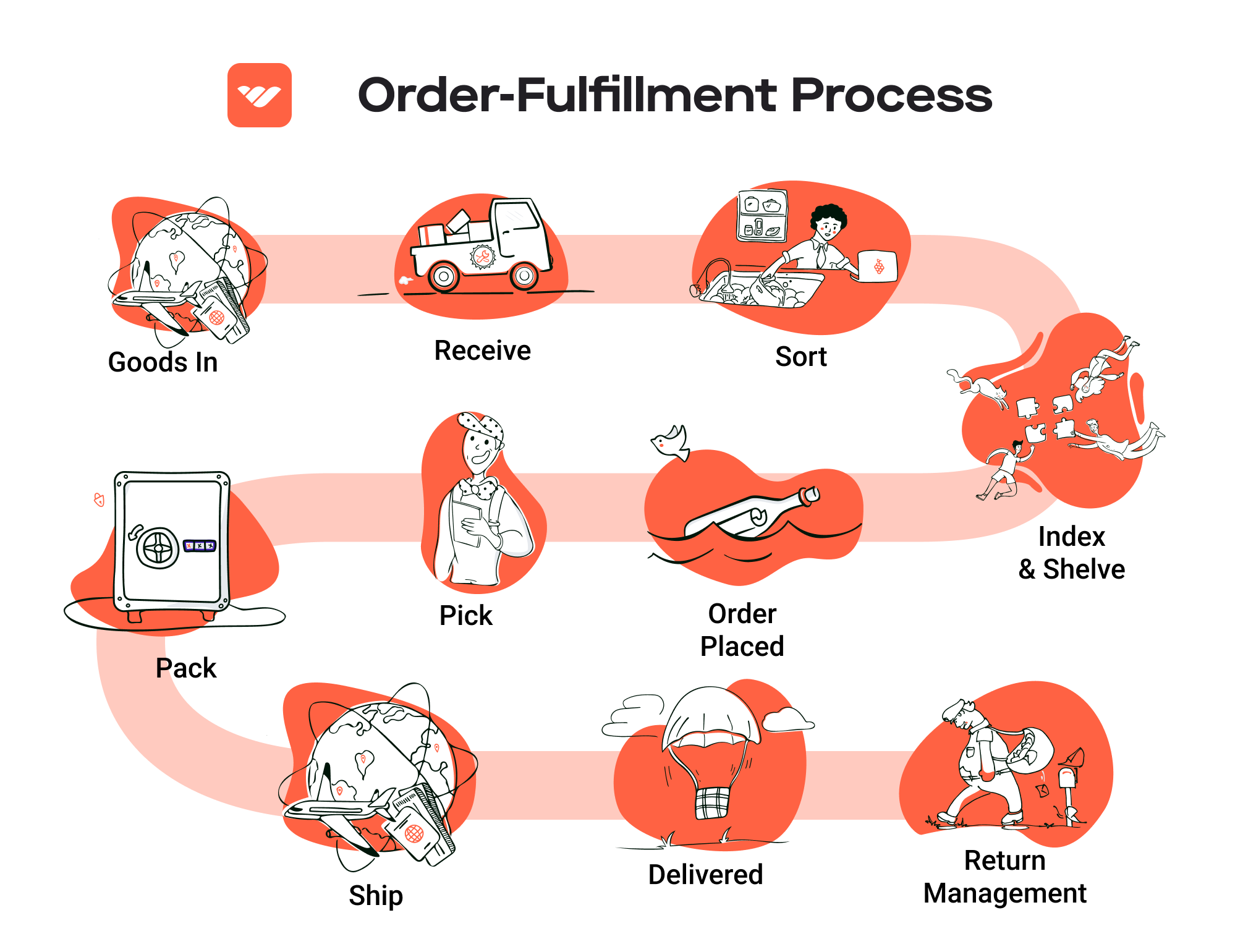
Cons of Using FBA
1. High Fees
FBA comes with several fees, including storage fees, fulfillment fees, and additional charges for long-term storage. These fees can add up, particularly for sellers with lower-margin products, potentially eating into profits.
2. Strict Inventory Rules
Amazon has strict policies regarding inventory management, including requirements for labeling, packaging, and inventory limits. Sellers need to stay compliant with these regulations to avoid penalties or having their listings suspended.
3. Commingling Risks
When using FBA, sellers’ inventory can be commingled with that of other sellers. This means that if a customer receives a damaged or subpar product, it can be difficult to ascertain who is responsible. This risk can affect brand reputation and customer satisfaction.
4. Less Control Over Fulfillment
While outsourcing fulfillment can simplify logistics, it also means less control over the fulfillment process. Sellers may find it challenging to manage how their products are packaged and presented to customers, which can affect branding and customer experience.
5. Dependence on Amazon
Using FBA can create a dependency on Amazon’s platform. Sellers may find themselves vulnerable to changes in Amazon’s policies, fee structures, or algorithms, which can impact their business operations significantly.
Who is FBA Best For?
Fulfillment by Amazon is particularly advantageous for:
-
Small to Medium-Sized Businesses: Companies that lack the infrastructure to manage their own fulfillment can benefit greatly from FBA’s streamlined logistics and customer service capabilities.
-
Sellers with High Sales Volume: Businesses that experience high sales volume can take advantage of Amazon’s efficient fulfillment processes to scale quickly without the burden of logistics management.
-
Brands Looking to Enhance Visibility: Sellers who want to leverage Amazon’s vast customer base and Prime membership can significantly increase their market reach through FBA.
-
Multi-Channel Retailers: Businesses that sell on multiple platforms can centralize their inventory management and fulfillment through FBA, simplifying operations across different sales channels.
-
Entrepreneurs Focused on Growth: For those looking to grow their e-commerce business without being bogged down by logistics, FBA offers a viable solution to manage fulfillment efficiently.
In summary, while FBA presents a compelling opportunity for e-commerce businesses, it’s essential for sellers to weigh the pros and cons carefully. Understanding how FBA aligns with their business goals and operational capabilities will be crucial in determining if it’s the right choice for their growth strategy.
Core Services Offered by Fulfillment Centers
Inventory Management & Warehousing
Inventory management and warehousing are foundational services provided by fulfillment centers that play a crucial role in the success of e-commerce businesses. This service involves the systematic storage, tracking, and management of products within a fulfillment center. Effective inventory management ensures that businesses have the right products available at the right time, minimizing the risk of stockouts or overstock situations.
The benefits of robust inventory management include:
-
Real-Time Visibility: Fulfillment centers utilize advanced inventory management systems that provide real-time data on stock levels, allowing businesses to make informed decisions about reordering and inventory levels. This visibility reduces the risk of losing sales due to unavailable stock.
-
Space Optimization: By leveraging the warehousing capabilities of a fulfillment center, businesses can save on overhead costs associated with maintaining their own storage facilities. Fulfillment centers are designed to maximize space efficiency, ensuring that products are stored in a manner that facilitates quick retrieval and shipping.
-
Scalability: As e-commerce businesses grow, their inventory needs often change. Fulfillment centers offer scalable warehousing solutions that can adjust to varying demands, enabling businesses to expand without the need for significant investment in additional storage facilities.
Pick and Pack Services
Pick and pack services are integral to the fulfillment process, involving the selection of products from inventory (picking) and preparing them for shipment (packing). This service is vital for ensuring that orders are fulfilled accurately and efficiently.
The advantages of utilizing pick and pack services include:
-
Efficiency: Fulfillment centers employ organized systems and trained staff to streamline the picking process. This leads to faster order fulfillment, which is essential for maintaining customer satisfaction in a competitive e-commerce landscape.
-
Accuracy: With dedicated quality control measures in place, fulfillment centers minimize picking errors, ensuring that customers receive the correct items. This accuracy helps reduce return rates and enhances customer trust.
-
Customization: Many fulfillment centers offer customizable packing options, allowing businesses to brand their packaging and include promotional materials. This adds a personal touch to customer orders, enhancing the overall shopping experience.
Kitting and Assembly
Kitting and assembly services involve the bundling of individual products into a single package or preparing items for sale in a specific configuration. This service is particularly beneficial for businesses that offer subscription boxes, promotional bundles, or products that require assembly before shipping.
The benefits of kitting and assembly services include:
-
Streamlined Operations: By outsourcing kitting and assembly to a fulfillment center, businesses can save time and resources. This allows them to focus on core activities like product development and marketing while leaving the logistical complexities to the experts.
-
Cost Savings: Fulfillment centers can often achieve economies of scale by handling kitting and assembly for multiple clients. This can translate into cost savings for e-commerce businesses, as they benefit from lower labor and materials costs.
-
Increased Flexibility: Kitting services enable businesses to respond quickly to market trends or customer demands by easily creating new product bundles or promotional kits. This agility can be a significant competitive advantage.
Returns Management (Reverse Logistics)
Returns management, or reverse logistics, refers to the processes involved in handling returned goods. Fulfillment centers manage this complex aspect of e-commerce, ensuring that returns are processed efficiently and effectively.
The key benefits of a well-managed returns process include:
-
Customer Satisfaction: A smooth returns process can significantly enhance customer satisfaction. Fulfillment centers handle returns promptly, ensuring that customers receive refunds or replacements quickly, which fosters trust and loyalty.
-
Data Insights: By analyzing returns data, fulfillment centers can provide valuable insights into customer behavior and product performance. This information can help businesses identify trends, improve product offerings, and reduce the rate of returns.
-
Cost Efficiency: Effective returns management minimizes the costs associated with handling returns. Fulfillment centers often have established procedures for inspecting, restocking, or disposing of returned items, helping businesses recover value from returned products.
In conclusion, partnering with a fulfillment center for these core services enables e-commerce businesses to streamline their operations, reduce costs, and enhance customer satisfaction. By focusing on their core competencies while leveraging the expertise of fulfillment centers, businesses can scale more effectively in a competitive marketplace.
How to Choose a Fulfillment Partner: A 6-Point Checklist
Location & Warehouse Network
Importance:
The geographic location of your fulfillment partner’s warehouses can significantly impact shipping times and costs. A strategically located partner in the Dallas-Fort Worth area, for instance, can facilitate faster delivery to a large portion of the U.S. market due to its proximity to major transportation hubs.
Questions to Ask:
– Where are your warehouses located, and how does this affect shipping times to my target market?
– Do you have a network of warehouses that can help optimize shipping routes?
– Can you provide same-day shipping from these locations?
Technology & Integrations
Importance:
In today’s e-commerce environment, seamless technology integration is crucial. Your fulfillment partner should offer a robust platform that integrates with your e-commerce systems, such as Amazon, Shopify, or eBay, to automate order processing and inventory management. This reduces manual errors and improves efficiency.
Questions to Ask:
– What technology platforms do you use for inventory management and order processing?
– Can your system easily integrate with my existing e-commerce solutions?
– Do you offer real-time tracking and reporting capabilities for inventory and orders?
Specializations (e.g., cold storage, oversized items)
Importance:
Different businesses have unique product requirements. If you sell temperature-sensitive products, oversized items, or subscription boxes, it’s vital to partner with a fulfillment center that specializes in these areas. This ensures that your products are stored and handled correctly, maintaining their quality and integrity.
Questions to Ask:
– Do you have specialized facilities for handling specific types of products, such as cold storage or oversized items?
– Can you accommodate unique packaging requirements for my products?
– What measures do you take to ensure the integrity of specialized products during storage and shipping?
Scalability & Capacity
Importance:
Your fulfillment partner should be able to grow alongside your business. As your order volume increases, your partner must have the capacity to scale operations without compromising service quality. This flexibility can save you time and resources in the long run.
Questions to Ask:
– What is your current capacity for handling orders, and how quickly can you scale up if my order volume increases?
– Do you have experience working with businesses that have seasonal spikes in demand?
– How do you manage overflow during peak times?
Pricing and Contracts
Importance:
Understanding the pricing structure and contract terms of your fulfillment partner is critical for budgeting and financial planning. Hidden fees can significantly affect your margins, so clarity in pricing is essential.
Questions to Ask:
– Can you provide a detailed breakdown of your pricing structure, including any additional fees for storage, pick and pack, or shipping?
– What are the contract terms, and is there flexibility for scaling or reducing services as needed?
– Are there penalties for early termination of the contract, and what is the process for ending the partnership if necessary?
Customer Support & Reviews
Importance:
Reliable customer support is essential for addressing any issues that may arise during the fulfillment process. A partner with a strong reputation for customer service can help mitigate problems quickly, ensuring that your business operations run smoothly.
Questions to Ask:
– What level of customer support can I expect, and how can I reach your support team?
– Are there dedicated account managers for each client?
– Can you provide references or reviews from other businesses that have worked with you?
Conclusion
Choosing the right fulfillment partner is a significant decision that can impact your e-commerce business’s efficiency, customer satisfaction, and overall growth. By carefully considering the factors outlined in this checklist, you can make a more informed decision that aligns with your business goals. Prioritize a partner that not only meets your current needs but also has the potential to support your future growth.
Understanding Fulfillment Pricing: A Breakdown of Common Fees
Initial Setup Fees
When partnering with a fulfillment center, businesses often encounter initial setup fees. These fees cover the costs associated with establishing your account, integrating your systems, and configuring the fulfillment process to meet your specific needs. Initial setup fees can vary significantly based on the complexity of your e-commerce platform and the level of customization required.
Calculation: Typically, these fees are a flat rate charged once, which can range from a few hundred to several thousand dollars. Factors influencing this cost include the integration of your e-commerce platform, the number of SKUs (stock-keeping units) to be set up, and the specific functionalities you require, such as reporting tools or inventory management systems.
Receiving Fees
Receiving fees are charged when your products arrive at the fulfillment center. These fees account for the labor and resources needed to unload, inspect, and store your inventory. Receiving fees can vary based on the volume of products, the complexity of the receiving process, and any special handling requirements.
Calculation: Generally, receiving fees are calculated based on the number of pallets or boxes received. For example, a fulfillment center may charge a per-pallet fee or a flat fee for each shipment received. Businesses should be aware that additional fees may apply for special handling, such as items requiring temperature control or fragile products.
Storage Fees (per pallet/bin)
Storage fees are charged for the space your inventory occupies within the fulfillment center. These fees are typically assessed on a monthly basis and can vary depending on whether you are using pallet storage or bin storage. Understanding your storage needs is crucial for accurately estimating these costs.
Calculation: Storage fees are usually calculated based on the space occupied, either per pallet or per cubic foot/bin. For instance, a fulfillment center may charge $10 per pallet per month or a set rate per cubic foot for smaller items. It’s important to monitor your inventory levels, as overstocking can lead to increased storage costs, while understocking may impact your ability to fulfill orders promptly.
Pick & Pack Fees (per item/order)
Pick and pack fees are incurred each time an order is processed. This fee covers the costs associated with retrieving items from storage, packing them for shipment, and preparing them for delivery. Efficient pick and pack operations are crucial for maintaining fast shipping times and customer satisfaction.
Calculation: Typically, pick and pack fees are calculated on a per-item basis or per order. For example, a fulfillment center might charge $1.50 for each item picked and packed or a flat fee of $3.00 per order regardless of the number of items. Understanding these fees can help you optimize your inventory management and order fulfillment processes.
Shipping Fees
Shipping fees are one of the most significant costs associated with fulfillment services. These fees cover the transportation of your products from the fulfillment center to your customers. Shipping costs can vary widely based on factors such as package weight, dimensions, destination, and shipping method (standard, expedited, etc.).
Calculation: Shipping fees are typically calculated based on the weight and dimensions of the package, the shipping service selected, and the distance to the delivery location. Many fulfillment centers negotiate bulk shipping rates with carriers, which can lead to cost savings for businesses. It’s essential to compare shipping options and consider the trade-offs between cost and delivery speed.
Tips for Getting an Accurate Quote
-
Provide Detailed Information: When seeking quotes from fulfillment centers, provide as much detail as possible about your products, order volume, and specific requirements. This includes the number of SKUs, average order size, and any special handling needs.
-
Ask About All Fees: Ensure you understand all potential fees that may apply, including initial setup, receiving, storage, pick and pack, and shipping fees. Ask for a comprehensive breakdown of costs to avoid unexpected charges.
-
Inquire About Discounts: Some fulfillment centers offer discounts for higher volumes or long-term contracts. Ask about any opportunities to reduce costs based on your business’s growth trajectory.
-
Evaluate Scalability: As your business grows, your fulfillment needs will change. Choose a fulfillment partner that can scale with you and provide transparent pricing structures that accommodate your growth.
-
Compare Multiple Providers: Don’t settle for the first quote you receive. Compare several fulfillment centers to assess their pricing structures, services offered, and customer support levels.
By understanding these common fulfillment pricing models and taking proactive steps to gather accurate quotes, e-commerce businesses can make informed decisions that align with their operational needs and growth objectives.
Frequently Asked Questions (FAQs) about Fulfillment
1. What is Amazon Fulfillment in Dallas, TX?
Amazon Fulfillment in Dallas refers to the process by which Amazon handles storage, packing, and shipping of products for sellers based in or shipping to the Dallas area. This is typically facilitated through Amazon’s Fulfillment by Amazon (FBA) program, which allows sellers to leverage Amazon’s vast logistics network to reach customers efficiently.
2. How does Fulfillment by Amazon (FBA) work?
FBA allows sellers to store their products in Amazon’s fulfillment centers. When a customer orders a product, Amazon picks, packs, and ships the item on behalf of the seller. Additionally, FBA sellers benefit from Amazon’s customer service and return handling, enhancing their overall customer experience.
3. What is the difference between a warehouse and a fulfillment center?
A warehouse primarily serves as a storage facility for goods, while a fulfillment center is designed specifically for processing orders and shipping them to customers. Fulfillment centers offer additional services such as inventory management, packing, and shipping, making them more integral to e-commerce operations.
4. What is a Third-Party Logistics Provider (3PL)?
A 3PL is a company that provides outsourced logistics services, which can include storage, inventory management, order fulfillment, and shipping. Partnering with a 3PL allows e-commerce businesses to focus on their core competencies while leveraging the expertise and infrastructure of logistics specialists.
5. How much do fulfillment services cost?
The cost of fulfillment services can vary widely based on factors such as order volume, storage space, and additional services required (like packaging or returns handling). Typically, costs are structured around storage fees (per pallet or cubic foot) and fulfillment fees (per order or item), so it’s essential to evaluate your specific needs and compare quotes from different providers.
6. What are the benefits of using a fulfillment center in Dallas?
Utilizing a fulfillment center in Dallas offers several advantages, including faster shipping times due to the central U.S. location, access to experienced logistics professionals, and the ability to scale operations up or down based on demand without incurring significant overhead costs.
7. How do I choose the right fulfillment partner in Dallas?
When selecting a fulfillment partner, consider factors such as their location, shipping capabilities, technology integrations, pricing structures, and customer service reputation. It’s also beneficial to request references and conduct a trial run to assess their operational efficiency and compatibility with your business needs.
8. Can I integrate my e-commerce platform with a fulfillment service?
Yes, many fulfillment centers offer integration with popular e-commerce platforms like Amazon, Shopify, and WooCommerce. This integration allows for automated order processing, real-time inventory updates, and streamlined communication between your store and the fulfillment provider, enhancing operational efficiency.
9. What types of products can be stored and fulfilled from Dallas fulfillment centers?
Dallas fulfillment centers can handle a wide range of products, including non-perishable goods, subscription boxes, apparel, electronics, and even temperature-sensitive items, depending on the facility’s capabilities. Always confirm with the fulfillment center regarding any specific product restrictions.
10. How quickly can orders be shipped from Dallas fulfillment centers?
Many Dallas fulfillment centers offer same-day shipping for orders placed before a specified cutoff time. This rapid turnaround is facilitated by efficient inventory management and order processing systems, allowing businesses to meet customer expectations for fast delivery.
Conclusion: Is Outsourcing Fulfillment the Right Move for Your Business?
Assessing the Benefits of Outsourcing Fulfillment
Outsourcing your fulfillment can be a game-changer for your e-commerce business. By partnering with a specialized fulfillment service, you can save valuable time that would otherwise be spent on logistics and operational tasks. This allows you to focus on what truly matters: enhancing your product offerings, optimizing marketing strategies, and improving customer experiences.
Scalability is another significant advantage of outsourcing. As your business grows, so do your fulfillment needs. A reliable third-party logistics (3PL) provider can easily adjust to fluctuations in order volume without requiring you to invest in additional infrastructure or workforce. This flexibility is essential for navigating seasonal spikes or unexpected demand surges, ultimately helping you maintain customer satisfaction and loyalty.
Moreover, leveraging the expertise of a fulfillment partner can significantly enhance your operational efficiency. These providers possess advanced inventory management systems and streamlined order processing capabilities, which translate to faster shipping times and improved accuracy. When your customers receive their orders promptly and correctly, it not only boosts your reputation but also encourages repeat business.
However, it’s crucial to choose the right fulfillment partner to align with your business goals and growth strategy. Take the time to research and vet potential providers, considering factors such as location, service offerings, technology integration, and customer support.
Take Action: Evaluate Your Current Fulfillment Process
As you contemplate the potential of outsourcing fulfillment, consider conducting an audit of your current shipping and logistics processes. Identify pain points and areas for improvement—this will provide you with valuable insights into whether a fulfillment partner could be the next strategic step for your business. Remember, the right partner can not only streamline your operations but also propel your brand towards greater success in the competitive e-commerce landscape.
Important Disclaimer
⚠️ Important Disclaimer
The information in this guide is for educational purposes. Fulfillment services, pricing, and platform features change frequently. Always conduct your own due diligence and consult with providers directly before making business decisions.
